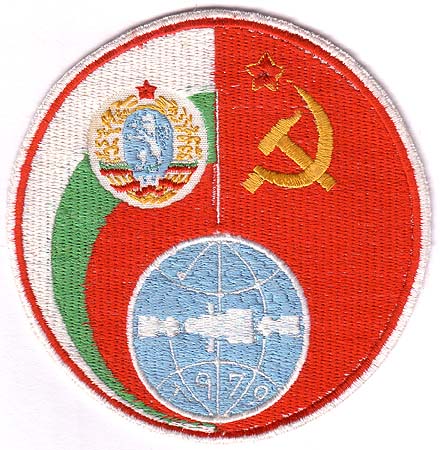
|
|

| Crew & Mission |
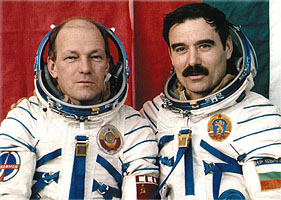 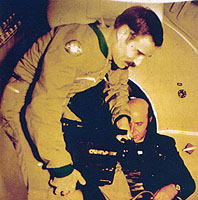 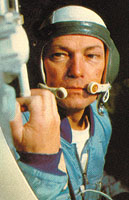 Left: Rukavishnikov and Ivanov wearing their training Sokols. The patch configuration is almost as it was on their flight Sokols, except for the seals on their chests, which were only worn on the intravehicular clothing. We also believe the blue/white type Interkosmos council patch shown here, was not flown. The Presentation Patch Set includes a yellow/red/blue version, with a blue border and cyrillic lettering. This would make sense, since Bulgarian script is cyrillic and Interkosmos council patches tend to be written in the native script of the guest cosmonaut. Center: The crew during IVA-training. Ivanov is wearing a TK-2 Training costume. Sigmund Jaehn had also been wearing a similar costume. In his case, it was light blue. Right: Rukavishnikov seen during IVA-training. He is wearing a light blue TK-2 Training costume. Soyuz-33 was the fourth Interkosmos mission. the mission, with callsign "Saturn" was launched on April 10, 1979 but failed to dock with the Salyut-6 station. Commander Nikolai N. Rukavishnikov and Bulgarian Interkosmos cosmonaut Georgi Ivanov returned to Earth on April 12, 1979. |
| The Artwork |
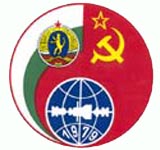 The Council for International Cooperation in the Exploration and Use of Outer Space (Interkosmos) was founded in 1976. Naturally, new emblems for uniforms and pressure suits were needed to reflect the cooperative nature of the missions. On December 14-15, 1977, a conference was held in Moscow by representatives of Bulgaria, Czechoslovakia, East Germany and the USSR, discussing the public relations aspect, the creation of the emblems and logos, and candidates for the flights. On December 23, 1977, Chairman B.I. Petrov of the Interkosmos council informed Zvezda General Director/Designer G. I. Severin announcing that Bulgaria, Czechoslovakia, and East Germany had agreed to participate in joint missions. Probably, it was in this letter that Zvezda was instructed to produce the Bulgarian, Czechoslowakian and East German joint mission Sokol-K suits and mission patches. The Council for International Cooperation in the Exploration and Use of Outer Space (Interkosmos) was founded in 1976. Naturally, new emblems for uniforms and pressure suits were needed to reflect the cooperative nature of the missions. On December 14-15, 1977, a conference was held in Moscow by representatives of Bulgaria, Czechoslovakia, East Germany and the USSR, discussing the public relations aspect, the creation of the emblems and logos, and candidates for the flights. On December 23, 1977, Chairman B.I. Petrov of the Interkosmos council informed Zvezda General Director/Designer G. I. Severin announcing that Bulgaria, Czechoslovakia, and East Germany had agreed to participate in joint missions. Probably, it was in this letter that Zvezda was instructed to produce the Bulgarian, Czechoslowakian and East German joint mission Sokol-K suits and mission patches. |
| The Real Thing |
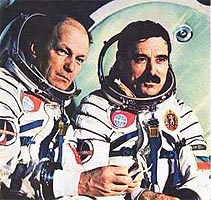 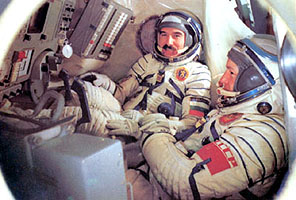 The cosmonauts in their training Sokols again. In the left picture, they are wearing a mission patch on the right chest. The patch was not on the flight Sokols, but it is one of the few pictures of a real patch we have found. Since the mission failed, inflight pictures were probably not released. It is not known to us what type of Interkosmos patch was flown on the mission, but the Presentation Patch Set contains a blue bordered version.
The joint mission patch was worn on the right sleeve of the intra-vehicular suits. The Interkosmos council logo (unknown version) was worn on the right lower torso, with the Soviet and Bulgarian seals at the upper left chest. On the Sokol suits, the Interkosmos council patch was worn on the right sleeve. On both suits, the flags were worn on the left sleeve. The Soviet flag was a felt, square lettered type on both the Sokol and the intravehicular suit.
|
| Source / Souvenirs |
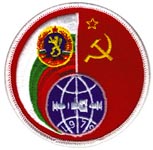 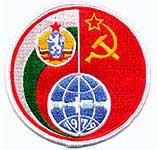 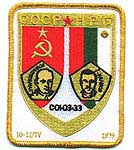 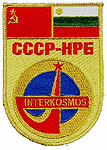 The Space Commerce Corporation reproduction (l) and the Stewart Aviation reproduction (center, left). The patcher at right are souvenir versions made by Eagle One Aerospace.
The patch was designed and produced by the Zvezda corporation. Two souvenir versions were made in the West by Stewart Aviation in England and Space Commerce Corporation in the United States. A related patch was produced by Eagle One Aerospace. The Stewart Aviation version is still in their catalogue; the SCC version is offered every now and then on eBay and the EOA-version might still be available from Cargo Bay Emblems. The original Soviet-made patch was made available to officials as part of a Presentation Set (shown below), which is scarcely seen in auctions.
The original patches shown on this page and the Stewart Aviation and EOA patches are in our collection.
|